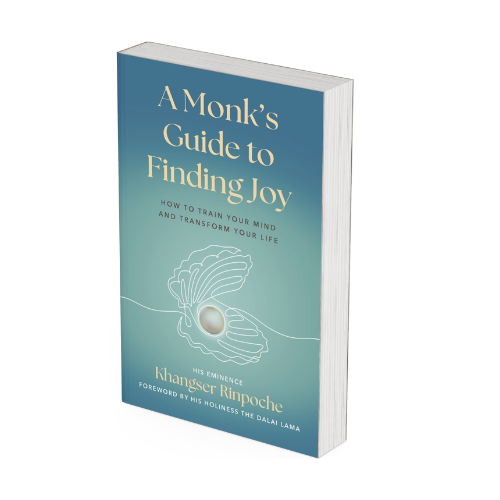A Monk’s Guide to Finding Joy
by Gelong Thubten
The Author: Gelong Thubten
Gelong Thubten is a Buddhist monk, meditation teacher, and author dedicated to making mindfulness and compassion accessible to modern audiences. Ordained in the Tibetan tradition for over 25 years, he teaches meditation worldwide, blending ancient wisdom with contemporary relevance. Thubten works with universities, businesses, schools, and hospitals, focusing on practical meditation applications to improve well-being, resilience, and inner peace.
Summary of A Monk’s Guide to Finding Joy: How to Train Your Mind and Transform Your Life
A Monk’s Guide to Finding Joy explores how mindfulness and meditation can transform life and cultivate lasting joy. Thubten explains that true joy differs from fleeting happiness and comes from within, independent of external circumstances. He offers step-by-step mindfulness practices, emphasising presence and compassion for oneself and others. The book addresses obstacles such as stress and negative thinking, providing strategies to reframe thoughts and accept impermanence. Thubten shares personal stories to illustrate mindfulness’s power, blending ancient teachings with practical advice for emotional well-being.
My Thoughts on A Monk’s Guide to Finding Joy
Reading this book was deeply reflective, reinforcing mindfulness’s role in a meaningful life. Thubten’s focus on joy as inner and independent of external factors resonates with my therapeutic approach. His accessible meditation guidance, especially on self-compassion and non-judgement, supports emotional resilience. The strategies for overcoming stress and negative thinking are highly relevant in today’s fast-paced world. Thubten’s personal anecdotes add authenticity, reminding us mindfulness helps us engage more fully and compassionately with life.
I Encourage Clients and Colleagues to Incorporate These Teachings
-
Focus on Inner Joy: Cultivate joy from within, independent of outside circumstances.
-
Practice Mindfulness and Meditation: Use regular mindfulness to increase self-awareness and reduce stress.
-
Embrace Self-Compassion: Foster non-judgemental awareness for personal growth and healing.
-
Reframe Negative Thinking: Learn to identify and shift negative thought patterns.
-
Accept Impermanence: Let go of attachments to reduce suffering and find peace.
-
Engage with Life Fully: Approach daily life with mindfulness and compassion.
In Summary
Gelong Thubten’s A Monk’s Guide to Finding Joy offers practical mindfulness and meditation tools for lasting joy and inner peace. Combining ancient wisdom with modern practice, it is essential reading for anyone seeking improved mental and emotional well-being.
A Monk’s Guide to Finding Joy
by Gelong Thubten
The Author: Gelong Thubten
Gelong Thubten is a Buddhist monk, meditation teacher, and author dedicated to making mindfulness and compassion accessible to modern audiences. Ordained in the Tibetan tradition for over 25 years, he teaches meditation worldwide, blending ancient wisdom with contemporary relevance. Thubten works with universities, businesses, schools, and hospitals, focusing on practical meditation applications to improve well-being, resilience, and inner peace.
Summary of A Monk’s Guide to Finding Joy: How to Train Your Mind and Transform Your Life
A Monk’s Guide to Finding Joy explores how mindfulness and meditation can transform life and cultivate lasting joy. Thubten explains that true joy differs from fleeting happiness and comes from within, independent of external circumstances. He offers step-by-step mindfulness practices, emphasising presence and compassion for oneself and others. The book addresses obstacles such as stress and negative thinking, providing strategies to reframe thoughts and accept impermanence. Thubten shares personal stories to illustrate mindfulness’s power, blending ancient teachings with practical advice for emotional well-being.
My Thoughts on A Monk’s Guide to Finding Joy
Reading this book was deeply reflective, reinforcing mindfulness’s role in a meaningful life. Thubten’s focus on joy as inner and independent of external factors resonates with my therapeutic approach. His accessible meditation guidance, especially on self-compassion and non-judgement, supports emotional resilience. The strategies for overcoming stress and negative thinking are highly relevant in today’s fast-paced world. Thubten’s personal anecdotes add authenticity, reminding us mindfulness helps us engage more fully and compassionately with life.
I Encourage Clients and Colleagues to Incorporate These Teachings
-
Focus on Inner Joy: Cultivate joy from within, independent of outside circumstances.
-
Practice Mindfulness and Meditation: Use regular mindfulness to increase self-awareness and reduce stress.
-
Embrace Self-Compassion: Foster non-judgemental awareness for personal growth and healing.
-
Reframe Negative Thinking: Learn to identify and shift negative thought patterns.
-
Accept Impermanence: Let go of attachments to reduce suffering and find peace.
-
Engage with Life Fully: Approach daily life with mindfulness and compassion.
In Summary
Gelong Thubten’s A Monk’s Guide to Finding Joy offers practical mindfulness and meditation tools for lasting joy and inner peace. Combining ancient wisdom with modern practice, it is essential reading for anyone seeking improved mental and emotional well-being.
“The greatest glory in living lies not in never falling, but in rising every time we fall.”
This quote speaks to the heart of resilience and the importance of learning and growing from failures, a key aspect of Matthew’s philosophy.
Recent Thoughts
Stay with the Feeling
admin2025-07-18T13:54:13+02:00July 18th, 2025|0 Comments
I see it every week in the clinic, and I recognise it in myself. The moment a feeling squeezes, we reach for the
When Your Feelings Flash Like a Dashboard Light
admin2025-07-28T14:25:40+02:00July 17th, 2025|0 Comments
Understanding Your Inner Emotional Compass I still remember the first time the oil light flashed during a late-night drive from a workshop, tired




